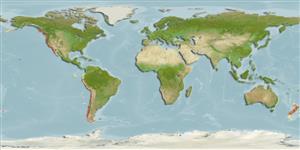Environment: milieu / climate zone / depth range / distribution range
Ecologia
marino demersale; distribuzione batimetrica 0 - 142 m (Ref. 2850), usually ? - 73 m (Ref. 6885). Subtropical; 55°N -
Eastern Pacific: Trail Island, Wark Channel, northern British Columbia to Bahia Santa Maria, southern Baja California, Mexico. Probably occurring in southeastern Alaska (Ref. 2850).
Size / Peso / Age
Maturity: Lm ? range ? - ? cm
Max length : 23.0 cm TL maschio/sesso non determinato; (Ref. 2850)
Short description
Chiavi di identificazione | Morfologia | Morfometria
Spine dorsali (totale) : 10 - 11; Raggi dorsali molli (totale) : 14 - 17; Spine anali: 0; Raggi anali molli: 14 - 17. Caudal fin large, barely rounded. Pelvic fins small.
Facultative air-breathing in the genus (Ref. 126274); Commonly found on sand bottom, also on mud bottom. Occurs in intertidal areas and up to 142 m depth (Ref. 2850). Feeds on shrimps and other crustaceans (Ref. 4925). Aquarium observations indicate that this is nocturnal (Ref. 2850).
Eschmeyer, W.N., E.S. Herald and H. Hammann, 1983. A field guide to Pacific coast fishes of North America. Boston (MA, USA): Houghton Mifflin Company. xii+336 p. (Ref. 2850)
IUCN Red List Status (Ref. 130435)
Threat to humans
Harmless
Human uses
Pesca: commerciale; Acquario: Acquari pubblici
Strumenti
Special reports
Download XML
Fonti Internet
Estimates based on models
Preferred temperature (Ref.
123201): 7.6 - 13.7, mean 10.4 °C (based on 188 cells).
Phylogenetic diversity index (Ref.
82804): PD
50 = 1.0000 [Uniqueness, from 0.5 = low to 2.0 = high].
Bayesian length-weight: a=0.00676 (0.00300 - 0.01523), b=3.17 (2.98 - 3.36), in cm total length, based on LWR estimates for this (Sub)family-body shape (Ref.
93245).
Trophic level (Ref.
69278): 3.6 ±0.55 se; based on food items.
Resilienza (Ref.
120179): Medio, tempo minimo di raddoppiamento della popolazione 1.4 - 4.4 anni (Fec=5,700).
Fishing Vulnerability (Ref.
59153): Low vulnerability (13 of 100).
